Adam raised this subject in the past day or so. The film is on Amazon Prime in “HD,” but is not free. (I still don’t know how they decide which ones are free.) Anyway, the “rental” charge is nominal, so I watched it.
It’s pretty interesting. It is more or less a docudrama of the famous Charles Schmid killings in the 60s. Schmid was known as The Pied Piper of Tucson because he continued to hang around high school long after he graduated, creating a sizable cult following of kids. His version of the Pied Piper’s flute music consisted of drugs, sex, rides, parties and a generous helping of nihilist, anti-establishment attitude. His posse worshiped him. He had sex with the girls and fixed the guys up with beer, drugs and his extra girls. Somewhere along the line his sex with the girls morphed into violence and he killed three of them.
The film tells the story almost fact-by-fact, changing little but the names of the characters. Since Schmid was such a charismatic guy, and his hold over the kids is a fascinating topic to study, the low-budget film has no trouble holding our attention.
The story naturally strayed from the facts here and there, taking a little dramatic license to make the story more compact and/or impactful. The deviations from fact created the best and worst moments in the film.
On the negative side of the ledger, there is a scene with Ed Asner in full grouchy, sarcastic Lou Grant mode as a powerful local figure who suspects the Schmid character of responsibility for the girls’ disappearance. This scene comes out of nowhere, and the character is dropped as suddenly as he appeared.
On the positive side of the ledger is the cult’s reaction to the crime scene when the killer takes dozens of police officers and heavy equipment operators out to dig in the desert at the location where he buried the bodies. The scene becomes a carnival of media, observers, cult members and food vendors. The kids should be horrified to find that their mentor is responsible for the violent murders of three of their best friends. Instead, they are extremely upset that one of their gang “ratted out” their guru. They express some horror when they see the decomposed bodies, but they are more upset that they will no longer be able to follow the tune of their Pied Piper. With that scene, the filmmakers were able to turn a simple true crime story into a scathing observation on the way we turn crime into entertainment, and on the nature of cult behavior. And those two observations seem to be correct ones. I have no trouble believing that hot dog vendors would turn up at a search for murdered kids, and I have also seen that cults really do behave like that. Manson’s followers didn’t care that they were taking human lives. Trump’s followers don’t seem to care that he apparently tried to overthrow the American government. The secular cultists stand by their gurus as staunchly as religious cultists stand by their deities.
Anyway, there are two scenes with some flesh. Both include excellent male nudity, but neither is very satisfying in terms of female flesh.
Belinda Montgomery has a rough, semi-consensual sex scene with the murderer as he rips off her nightie. Belinda has never done a nude scene, so this would have been a nice find. Unfortunately, the scene is way too dark, and brightening it does not seem to reveal any sign of a nipple. Perhaps your eyes will be sharper than mine:
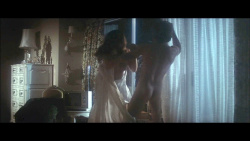
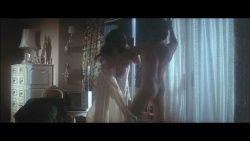
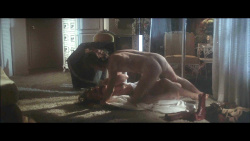
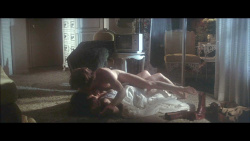
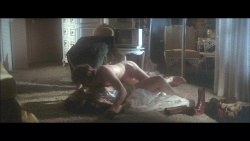
The other nude scene is legit in that there are bare breasts to be seen. Some rowdy rips off a girl’s bikini top in the local public pool, whereupon four other girls take revenge by ripping off the kid’s swimsuit. The problem with this scene is that the girl is not credited despite the fact that her character has a name and some dialogue. I can narrow it down to maybe three possibilities, but I can’t come up with a certain ID.

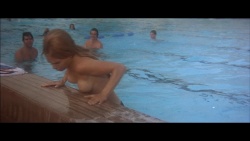

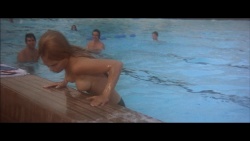

Amazon doesn’t own the films so they have to work out a deal for the rights to stream movies. Sometimes they work out a deal to stream a package of movies for a certain period of time so it ends up free on Prime. Outside of that they can make a deal to stream a movie for an additional price where both Amazon and the title owner can make a little money.
The copyright owners don’t want to make everything they own available all the time at a low price as it devalues all movies. They prefer to make most of the titles available at an extra cost. As the market gets flooded with more and more streaming content, the pressure will be on them to make things more freely available. I don’t pay extra for any of these films no matter how low. They got us with high cable prices for decades, now it’s time for payback.
1.I thought the Ed Asner character was meant to show how all the adults (except for his mother) were on to him. Maybe not all that he was a murderer, but that he was a charismatic, shallow phony pretending to be sophisticated but really having nothing to offer. The Ed Asner character knew it, the professor knew it, the military recruiters knew it, and the police knew it.
2.There were two changes in the film from the real story that I think were meant to be significant: the time was shifted to the late 1960s and the setting was shifted to some small San Diego suburb.
I think the suburbia setting was meant to highlight the negatives associated with the suburbs at that time (“another Pleasant Valley Sunday”) and, in addition to the film being a comment on turning crime into entertainment, it was also an examination into the ennui and nihilism of the youth among late stage hippiedom.
Of course, I might be reading too much into the film, but if that is the case, I think it was clearly prescient as the ‘we generation’ morphed into the young ‘me generation’ adults of the 1970s with their tacky bell bottoms and lava lamps.
On the other hand, the film could have been making oblique references to the somehow seemingly forgotten low level (far left) terrorism of the Black Panthers and the Weather Underground. Bernadine Dohrn and her ilk were every bit as sick as Charles Shmid.
Anyway, to end off on a more happy note, Shiloh, if you weren’t aware, the lovely Gretchen Corbett wears a rather skimpy bikini on an episode of Columbo called “An Exercise in Fatality.”
Even without her bikini scene, it’s one of my favorite Columbo episodes, with Robert Conrad playing an oily grifter owner of a chain of second rate health club franchises. He tries to explain why he is overcharging to one of the franchise owners by saying “I need to maintain quality.”
Pat Harrington Jr, from (the original) One Day at a Time (as well as a very good comedic writer in his own right) played Conrad’s accomplice/assistant. When Columbo brings up Harrington’s shady past, Conrad defends him explaining “he’s as honest as I am!”
There is also an unecessarily lengthy scene with an actress who looks just like Sigourney Weaver, but isn’t. I’m pretty positive the reason for this scene and other similar scenes in Columbo episodes was so that they could be deleted in syndication so that the important scenes would be left uncut.
For anybody interested, the episode also features one of the few times Columbo displays anger.
I don’t fully agree with your assessment. To the extent that adults were on to him, the Asner character would have been redundant. The police, his lit teacher, and Billy’s mom were obviously aware that he was a phony, even when they didn’t realize all the worst details. It was particularly obvious that the police knew he was trouble, despite his having Eddie Haskelled them.
The script never made it clear who Asner was supposed to be, and why he was so powerful. Did he own a large local business? If so, why did he employ hired thugs? Was he in organized crime? If so, why did he start out so tough, then ultimately just let the guy go? And why did they just drop this entire sub-plot after introducing it? It introduced an air of surrealism into an otherwise grounded story.
The real life equivalent of Asner did not let the matter rest there. The whole mafia involvement was basically not included in the script, and it may have been the most interesting part of the saga. It could be an entire movie of its own. At one point, the San Diego police were actually protecting Schmid from the mafia! (And, yes, in this case it was San Diego, not Tucson.)
I don’t really agree that the military recruiters were on to him. Many draftees tried to use the homosexual dodge in those days. The lefty activist Paul Krassner advised reluctant draftees that being a “hoaxosexual” was the surest route to rejection. (Just in passing, I would have called it a “fauxmosexual.”) Given that, the military shrink must have maintained plenty of skepticism about such a claim, and yet the service apparently accepted his claim and he was never drafted.
I had a completely different interpretation of his experience with the army. You suggested he was unable to fool them. My interpretation was that because he WAS able to fool the hardened and well educated army shrink, he felt that he could con anyone, and thus got an inflated sense of his own persuasive powers.
Remember that the killer was not done in by adults having spotted the flaws in his own stories, but by simple romantic jealousy. (1) The murder’s lust for Belinda Montgomery forced one of his jealous female cultists to blurt out some revealing details. (2) Billy ended up ratting the murderer out because of his fear for the girl he had a crush on. He was one of the very few who knew for sure that his friend was a killer, causing him to fear for the life of the girl he liked.
(In real life, the Billy character told his grandparents and the police.)
Did you know – 50 years after the fact, the real-life equivalent of Billy published a tell-all that he had written at the time of the investigation? It had been gathering dust for all those decades until his daughters persuaded him to publish it.
Final point. The most chilling part of the real story was that Schmid’s murders were common knowledge among the local youth, but that they all kept the secret from parents and police until “Billy” (actually Richard Bruns) squealed:
Time magazine reported:
“Almost as fantastic as the murders themselves was the disclosure that at least 30 teenagers, all friends of Schmid’s, had apparently heard him brag about the crimes — and said nothing. Confided one 16-year-old coed at Tucson’s Palo Verde High School: ‘A lot of people knew, but it was already too late. Telling would just have made it tough on everyone.'”
A hard stress on this point could have made the movie even more chilling.
—-
SIDEBAR: four other people really dodged the bullet in the Schmid saga. After a prison escape, Schmid and another convicted serial killer held four people hostage and let them go unharmed. Some angel was watching over those four!
Very good point with the mother. I forgot about her. I also had no idea there was any Mafia connection to the Schmid case. That is bizarre.
On the other issue, this is Blythe Danner wearing a very short tennis skirt in the Columbo episode Etude in Black
And this is Gretchen Corbett wearing a skimpy bikini and other outfits in the Columbo episode An Exercise in Fatality.
Both the franchisee owner and his wife seperately ask him “what do you do with all that money?” In addition to Robert Conrad saying “I need to maintain quality”, in answer to both, he replies “All the money goes back into the franchises. When I grow, you grow.” Wonderfully oily.
Ahh Belinda Montgomery IIRC watched the movie (VHS) specifically looking for any nudity. Gretchen Corbett was of the same ilk back in the day ie Jaws of Satan. Mainly TV actresses who appeared in everything under the sun, but never actually did a revealing nude scene. Digressing …
Good to know this movie actually had a plot. 😛 And yea, they didn’t actually embellish w/creative writing, rather they stole directly from the Manson cult.
Dorothy Parker ~ “The only ism Hollywood believes in is plagiarism.” Like most movies, especially nowadays, lather, rinse, repeat.
And so it goes …